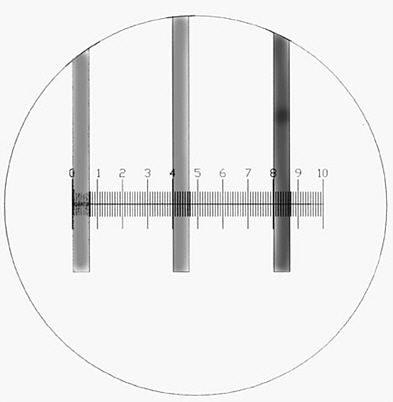MMM When you grow up in the US and live with "inches and feet" all your life, it is quite hard to visualize the size of something when you see measurements given in millimeters, or meters. I can picture in my head something that is 1/32 inch, but I could not "view in my head" something that is 250 microns or 800 microns, except of course that the latter is larger. Micscape magazine printed an article called Microscopy scales: Measurement in the micro-small world, 1996 by Alan Maude. This article gives a beginner a very good grasp of what a "micron is". In my first attempts to grasp this knowledge, I put a millimeter scale under the 4x objective and could see my field of view was about 4 millimeters. Well this worked OK for a very rough estimate of larger items, but all I was doing was guessing as to what size this or that might be. I have several microscope books with lots of color pictures telling me how many microns this or that is. I wanted to be able to measure these things directly. In order to do this one needs an eyepiece with a built in reticle. These can be purchased from almost any microscope shop. In my case I had a 10X eyepiece with a pointer in it. The pointer was sometimes very useful, but the majority of the time it always seemed to get in my way so I purchased another eyepiece without a pointer. I replaced the pointer with a Swift eyepiece micrometer Part Number MA6653. It had a scale going from 1 to 100 units in one-unit step. The reticule fit perfectly in the eyepiece in the same place the pointer was located. I then installed the snap ring that had held the pointer. I found that one has to be very careful about getting dust and smudges on the glass, and to get the scale in the right orientation. Using the Reticle. The actual physical size of the reticule scale as seen with the naked eye on the 19-mm glass is 10 mm long; this makes each division 100 microns. No matter which objective you use, the scale will always appear the same size in your eyepiece. In order to know how many microns each scale division represents with each objective turns out to be simplicity itself. Divide the 100 microns by the objective power. A 4X objective = 100/4 = 25 microns per division. A 10X objective = 100/10 = 10 microns per division. All microscopes are not the same; my two have different fields of view and magnifications using the same objectives and eyepiece. If you do not know the actual size of your reticule scale a really good known object to measure is a Millimeter ruler. The markings on the ruler appear rather large so I position the zero mark of the scale on the left edge of one of the rulers millimeter lines, and measured to the left edge of the next line. (See example).
Figure #1 I measured several lines like this to make sure the readings came out the same. With my monocular microscope I got 40 reticule lines to 1 millimeter. 1000 divided by 40 = 25 microns per each reticule line. My binocular microscope has a 1.25X additional magnification in the bino' head. This makes a 10X eyepiece and a 4X objective really 50X. This is proven with the millimeter rule by measuring 50 scale units per millimeter, or 20 microns per each reticule division. How accurate is this? Well it depends on what you are measuring and with what objective. Using the 4X is not going to be very accurate on small objects. It is hard to read any closer then ½ division with any assurance, and with each division being 25 microns or so its hard to get too close. But as you increase power up to the 40X where each division equals 2 ½ microns you can get very accurate readings. The amazing thing about doing something like this is that after taking lots of readings with the reticule, you soon begin to be able to guess at sizes with a surprising degree of accuracy. The really fun part comes when trying to measure critters that just will not stand still. |
